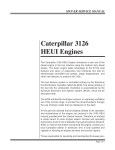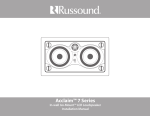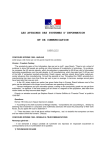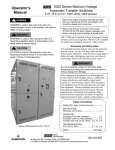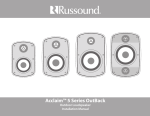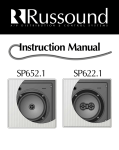Download Russound ACCLAIM 7 Installation manual
Transcript
Acclaim™ 7 Series In-ceiling Twist & Tilt™ Loudspeaker Installation Manual Introduction Introduction Thank you for selecting the Russound Acclaim 7 Series In-ceiling Speakers. Like all Russound speakers, they combine acoustic technology with durability and will provide years of musical enjoyment. The Acclaim line provides solutions for background music, dedicated music listening and home theater. The 7 Series combines premium acoustic materials, with our most advanced drivers to deliver exceptional performance in every application. From background music to spectacular surround sound, Acclaim speakers offer the finest sound around. Twist & Tilt™ technology allows Acclaim ceiling speakers to deliver the best direct listening performance by modifying their dispersion angle 15°, to focus sound on the prime listening area. For general background sound delivery, Twist & Tilt speakers can be set for uniform dispersion, filling the room with excellent sound. This ability to focus the sound where you want it most provides increased location flexibility with heightened fidelity. Better attention to aesthetic location is now possible, without compromising performance. In addition to Twist & Tilt focused dispersion and easy mounting features, Russound Acclaim 7 Series speakers feature high quality drivers, sophisticated crossover networks, and advanced designs to ensure optimum reproduction in your home, no matter what the source material may be. Several models offer Treble and Bass frequency adjustment switches. This adjustment allows you to tailor the sound of the Acclaim speakers to better match the listening environment. The three-position switches offer +3dB, -3 dB, and 0 dB settings. They are located on the front baffle of specific models. 2 Russound In-ceiling Loudspeaker Installation Manual Preparation / Wiring INfo Installation Tips Speaker Wire The amount of wire needed varies with speaker placement. Label speaker wires with left, right, and room location. What kind to use: We recommend using Russound AW series speaker cable or any reputable brand of 16 to 12 gauge multi-stranded wiring for amplifierto-speaker connections. Selecting the proper gauge: Wire is measured in gauges: the bigger the number, the smaller the wire. The gauge of wire needed is determined by the distance between your amplifier/receiver and the speakers. The longer the run, the heavier the gauge needed. Use the following chart as a guide: Length 0' to 100' 50' to 150' 100' to 200' Minimum Gauge 16 14 12 + • T-bar "drop ceilings" with very thin fiberboard panels which can buzz and vibrate. If needed, reinforce the drop-in panel with wood or particle board. • Ceilings where there are pipes, heating ducts and especially AC wiring in the general vicinity. Speaker Wire Paths • Avoid running speaker wires close to house electrical wiring for any distance. If you have to run them parallel, leave two feet between the wiring. Speaker wires should cross AC lines at a 90° angle. • The entire path between speakers and amplifier should be clear and unobstructed. Confirm placement for a wall port close to the intended location of the amplifier or receiver. If the conductors are not sheathed in colored jackets, be consistent with usage. The standard colors on the terminals are red Positive (+) and black Negative (-). If the wire has transparent insulation, one conductor will be copper-colored (+) and the other silver-colored (-). If the wire has an opaque insulation, the conductors are differentiated by a series of ribs or grooves, a stripe, or dotted line on one conductor. Use and mark these as the Positive (+) conductor. - When installing the speakers, avoid: - • Label speaker wires at each end with Left and Right and the room location. Impedance Matching for Amplifiers and Speakers Not all amplifiers or receivers can safely operate two sets of speakers at once. If you intend to use more than one pair of speakers at a time it’s important to consider both the impedance of the speakers and the capabilities of the amplifier or receiver you’re using. Turning the bass frequency adjustment switch from +3 dB, to 0 dB, to -3dB will change the impedance from 4 ohms, to 5 ohms, to 6 ohms respectively. + Typical usage of speaker wire conductors Russound In-ceiling Loudspeaker Installation Manual 3 Preparation / Speaker Placement Use and Placement Determine the intended use and placement of the speakers in the room. If they are going to be your primary listening source in a room, you need to consider some other factors to insure proper imaging. The term "stereo imaging" refers to a speaker system’s ability to project music so that it sounds like the performers are in a three-dimensional space between the speakers. The Acclaim Twist & Tilt speaker design provides the option of either uniform or focused dispersion, ensuring that high quality sound fills the chosen listening area. This ability to focus the sound where you need it most provides increased flexibility with heightened fidelity. After the frame is secured, the speaker/baffle portion installs with a simple twist. The Twist & Tilt technology offers the option of tilting the driver/baffle assembly 15° to focus the sound towards the chosen listening area. A zero° tilt allows for uniform dispersion. Focused dispersion - using 15° tilt 4 Uniform dispersion - using 0° tilt Russound In-ceiling Loudspeaker Installation Manual Preparation / Speaker Placement Speaker Placement in the Room Bass frequencies are emphasized when ceiling speakers are placed close to a wall. Avoid placing one speaker in a corner and another on a long flat surface. The best acoustic performance will result if both speakers are placed in similar positions and face a similar type of surface. The ceiling surround speakers should be placed directly to the sides or rear of the prime listening position, but be aimed toward the listener. This configuration is also suitable for a TV/movie and music mixed use. If the prime purpose of the surround system is to listen to music, the ceiling speakers should be aimed at the prime listening position. Acclaim In-ceiling speakers may be used for rear surround sound channels by placing them just behind the viewers. Refer to the 5 channel placement diagram. Refer to the details at right for sample In-ceiling placement options. • Good placement for serious listening: Stereo pair In-ceiling. 6' to 8' (1.8m-2.4m) apart, on the long wall of a rectangular room, centered on the listening area. Good Placement Serious Listening Best Placement Serious Listening • Best placement for serious listening: Stereo pair In-ceiling. 6' to 8' (1.8m-2.4m) apart, on the short wall of a rectangular room, centered on the listening area. • Good placement for background listening: Stereo pair behind, above or to the sides of the main listening area. 6' to 8' (1.8m-2.4m) apart, centered on the listening area. • Surround sound: The multiple surround locations can all be made to work as long as the speakers are properly directed. The ceiling speakers should be directed so that the sound is aimed toward the listener. Good Placement Background Listening Russound In-ceiling Loudspeaker Installation Manual Home Theater Surround Sound 5 Preparation for Installation Pre-wire or Pre-construction Retrofit Installation Locate all obstructions (AC wiring, plumbing, duct work, studs, and joists). Route the speaker wire to the speaker location avoiding all obstacles. Locate existing pipes, duct work, and AC wiring before cutting any holes in the ceiling. Russound offers Speaker Rough-In Brackets that can be fastened to the adjacent studs. Once the dry wall is installed, the opening is cut out. There are holes molded into the bracket for speaker wire tie-off to keep the wire from being lost during construction. 1. Center the cardboard template between adjacent joists, avoiding all wiring, pipes, duct work, and lightly mark the outline with a pencil. Then use a keyhole/drywall saw or motorized spiral-cut tool to make the opening. Make sure the speaker cutout (hole) doesn't extend further than 1/4" (0.6 cm) from the inside of the mounting bracket. 2. Score the outline of the template with a utility knife to prevent chipping. If dealing with lath and plaster or thick paneling, drill 1" (2.5 cm) holes in several places around the pencil outline. Use a fine-toothed keyhole saw or hacksaw blade with slow strokes to saw through and remove the inner surface. Run two pair conductors for single point speakers. Rough-in Bracket Stud / Joist Screw Speaker Cable Drill Pilot Hole Mark template outline Test for stud clearance Score template outline Bracket Installation Retrofit Installation 6 Russound In-ceiling Loudspeaker Installation Manual Cut out opening Preparation for Installation Additional Tips / Considerations Painting the Speaker Frame and Grille • If possible, run speaker wires after AC wiring is in place to avoid induced hum caused by close parallel proximity of the two types of wire. Russound Acclaim Speakers have a designer white finish that can be painted with ordinary latex paint. Remove the speaker baffle before painting. • Secure speaker wires in place against a stud along vertical runs with insulated staples only. Do not pierce the wire insulation. Allow a bit of slack for expansion of building materials. 1. Remove the speaker grilles. From the back of the speaker, push the clamp (dog-ear) towards the grille to loosen it so you can pull it off. If the speaker is already installed use a slightly bent paperclip to remove the grille. • Route horizontal wire runs through holes drilled in studs at roughly equal heights. 2. Twist and remove the baffle from the frame. Remove the scrim cloth from the grille and set aside. • The speakers should not be installed until the wallboard is in place. In the meantime, leave several feet of wire coiled up and secured to the back side of the mounting frame. Excess length can be removed during final assembly. 3. Paint the outer speaker frame and grille separately. Use the same coverage on both the grille and frame. Russound recommends diluting the latex paint with water 4:1 or 5:1 proportionally. • When installing the drywall, make sure the speaker cutout hole doesn’t extend farther than 1/4" (0.6 cm) from the inside of the mounting frame. • Any speaker installed in a ceiling should have a safety wire firmly tied between the back of the speaker assembly and the frame of the building. Use any strong insulated wire and connect it to the speaker frame or baffle, being careful not to let it interfere with the speaker’s operation. The other end should be firmly attached to the joist or flooring above using a hook, nail, or other reliable fastener. 4. While the paint is still wet on the grille, and the grille is not in the frame, use a gentle burst of compressed air against the outside surface to clear the fine holes in the mesh. 5. After the paint has thoroughly dried, continue with the installation. Frame • Terminate the wires in an outlet box attached to a stud or retrofit junction box at the exit location. Utilize an outlet plate which has connections for speaker wire terminations. Russound dealers offer a full line of Russound PlateMate™ connection systems. • After the drywall is secured and finished, install the speakers as described in this manual. Do not attach the scrim cloth and grill until the speaker has been connected and secured in the ceiling. Baffle Scrim Cloth Remove from Grille before Painting Grille Speaker Assembly Russound In-ceiling Loudspeaker Installation Manual 7 installation Installation 1. Remove the grille from the speaker, if applicable. Use the clamp (dog-ear) to push the grille out from the back side. 2. Connect the speaker wire to the speaker terminals: • Leave about 2' (60 cm) of wire extending through the ceiling cutout. • Pull the conductors apart so the last two inches are separated and remove 1/2" (13 mm) of insulation from the end of each conductor. • Twist the strands in each conductor into tight spirals. • Attach the speaker wires to the red and black speaker terminals. Connect the Positive (+) conductor to the Red terminal and the Negative (-) conductor to the Black terminal. Make sure that no stray strands of wire are touching the other conductor or terminal. • Single point speakers have four terminals; Right(+), (-) and Left(+), (-). Run an extra pair of conductors and observe proper polarity when making connections. 4. The baffle is marked with a 0° for uniform dispersion and a 15° for focused dispersion. If the baffle is already installed in the frame for the appropriate dispersion skip to step 7. If the speaker needs to be tilted for a focused dispersion, carefully twist and remove the baffle. Align the 15° with the arrow on the frame. Grasp the speaker baffle at the tweeter bridge, being careful not to come in contact with the tweeter itself. 5. Line up the tabs by sighting through the molded cutouts in the baffle. Insert the tabs into the tab openings and firmly push the baffle up into the frame slots. 6. Twist the baffle clockwise until it locks into the slots. 0° (+) (-) Or (+) (-) Insertion of speaker wire on back of speaker baffle 15° 0° Tilt Uniform Dispersion 3. Connect a safety wire from the building structure to the speaker frame or through the speaker basket. It should not interfere with the speaker operation. Safety wire Arrow Align 0° or 15° on baffle with arrow on frame Attach Safety Wire 8 15° Tilt Focused Dispersion Russound In-ceiling Loudspeaker Installation Manual Installation Installation (continued) 7. Center the frame in the cutout. If the speaker is being installed with a 15° tilt, the small arrow molded into the frame should be pointing in the direction of the tilt. If the speaker is being installed with no tilt, the orientation doesn't matter. Rotate the frame as needed before tightening the screws. Tighten the screws equally until the clamps secure the frame. Do not overtighten. 8. Secure the baffle to the frame with the small #1 Phillips screw. The hole for the screw is located at the "lock" icon on the baffle edge. This ensures the baffle and frame will not separate. Do not overtighten the earthquake screw. Cutout Safety wire Speaker Cable Earthquake Screw As screws are tightened clamp will rotate out and snug against the drywall. Frame Lock Icon Secure Baffle to Frame Arrow molded into the frame - If using focused dispersion, point in the direction desired before tightening clamps. Screws Install Speaker Frame Russound In-ceiling Loudspeaker Installation Manual 9 Tests and Adjustments Listening Test Adjusting the Frequency Response It’s a good idea to test everything at this point. 1. Turn on your stereo system or music source. Make sure that the volume control is turned down and that the balance control is set to center. 2. Gently turn up the volume. You should hear music coming out of your new Russound Speakers! (If you don’t, refer to the troubleshooting guide.) 3. Now rotate the stereo’s balance control all the way to the left. Sound should only come out of your left speaker. If it comes out of the right speaker, skip to Step 5. 4. Rotate the balance control all the way to the right. Sound should only come out of the right speaker. Several models are equipped with Treble and Bass frequency adjustment switches. Turn the switch to change the settings. +3 dB: Increases the loudness of the selected frequency (Bass or Treble) -3 dB: Reduces the loudness of the selected frequency (Bass or Treble) 0 dB: Selected frequency remains neutral (recommended start setting) Treble adjustment Bass adjustment 5. If sound comes from the right speaker when the stereo’s balance control is turned to the left, you’ll need to change the connections on the back of the amplifier/receiver. Note: Turn off the amplifier. Swap the wires attached to the left and right speaker terminals. Frequency Adjustment Tweeter Adjustment Grille Installation The tweeters pivot and should be aimed toward the intended listener. Before installing the grille, gently press on the outside of the tweeter ring as shown. (Not applicable for the 7C74S and 7C85S) After all adjustments and listening tests are made install the grille. Insert the speaker grille by placing it over the speaker baffle and aligning its edges in the frame. Press gently into place, taking care not to scratch the frame finish or bend the grille. In most installations, the grilles will fit tightly without causing vibration. If any audible vibration does occur, use the pre-cut lengths of special damping/adhesive material. Press only on the outer ring of the tweeter. Pressing on the interior of the tweeter dome will damage it! Outer Ring Tweeter Dome Tweeter Adjustment 10 Russound In-ceiling Loudspeaker Installation Manual Troubleshooting Guide Troubleshooting Guide Before returning your Russound speakers for service, try these simple remedies first. No sound from either speaker: • Incorrect source selected on receiver or preamplifier. • Mute button pressed on receiver. • Wrong speaker output selected; many receivers have an "A" and "B" speaker switch. Make sure it is in the correct position. • In-wall Volume control not turned up or wired incorrectly. • If using a speaker selector, room/station not turned on or improperly connected. No sound from one speaker: • Unsecured connection at either the speaker or amplifier - double-check all connections. • Balance control turned all the way left or right - return it to center. • Bad connecting cable between sound source and amplifier - try a new cable. • Check for stray wire strands crossing the speaker terminals. • Defective speaker - contact your Russound dealer or call Russound Tech Support at 603.659.5170. • Any other problems not listed, discuss with your dealer or call Russound. Russound In-ceiling Loudspeaker Installation Manual 11 Technical Specifications Model: Description: Woofer: Tweeter: Cutout: Mounting Depth: Dimensions: Terminals: Grille: Recommended Power: Sensitivity: Frequency Response: Frequency Range: Nominal Impedance: Unit Weight: 7C51 2-way In-ceiling 15° Twist & Tilt Loudspeaker Pair 5.25" (13.3 cm) Vacuum Formed Polypropylene Pivoting 0.5" (1.3 cm) Polyamide 6.75" (17.1 cm) diameter 4.5" (11.4 cm) 8.25" (21 cm) diameter Spring terminals Aluminum 10 - 75 watts 87.5 dB SPL (2.83V @ 1m) 58 Hz - 18 kHz ± 3 dB 45 Hz - 18 kHz -6/+3 dB 6 ohms 2.5 lbs (1.1 kg) Model: Description: Woofer: Tweeter: Cutout: Mounting Depth: Dimensions: Terminals: Grille: Recommended Power: Sensitivity: Frequency Response: Frequency Range: Nominal Impedance: Unit Weight: 7C72 2-way In-ceiling 15° Twist & Tilt Loudspeaker Pair 7" (17.8 cm) Vacuum Formed Polypropylene Pivoting 1" (25 mm) Silk 8.375" (21.3 cm) diameter 4.5" (11.4 cm) 9.75" (24.8 cm) diameter Spring terminals Aluminum 10 - 85 watts 91 dB SPL (2.83V @ 1m) 50 Hz - 18 kHz ± 3 dB 38 Hz - 18 kHz -6/+3 dB 6 ohms 3.26 lbs (1.5 kg) Model: Description: Woofer: Tweeter: Cutout: Mounting Depth: Dimensions: Terminals: Grille: Basket: Recommended Power: Sensitivity: Frequency Response: Frequency Range: Frequency Adjustment: Nominal Impedance: Unit Weight: 7C57 2-way In-ceiling 15° Twist & Tilt Loudspeaker Pair 5.25" (13.3 cm) Woven Yellow Kevlar Pivoting 1" (25 mm) Aluminum/Magnesium Alloy 6.75" (17.1 cm) diameter 4.5" (11.4 cm) 8.25" (21 cm) diameter Nickel Plated binding post Aluminum Cast Aluminum 10 - 125 watts 88 dB SPL (2.83V @ 1m) 57 Hz - 27 kHz ± 3 dB 47 Hz - 27 kHz -6/+3 dB Treble and Bass switches 4/5/6 ohms 3.32 lbs (1.5 kg) Model: Description: Woofer: Tweeter: Cutout: Mounting Depth: Dimensions: Terminals: Grille: Recommended Power: Sensitivity: Frequency Response: Frequency Range: Nominal Impedance: Unit Weight: 7C74 2-way In-ceiling 15° Twist & Tilt Loudspeaker Pair 7" (17.8 cm) IMPP with Kevlar Fibers Pivoting 1" (25 mm) Silk 8.375" (21.3 cm) diameter 4.5" (11.4 cm) 9.75" (24.8 cm) diameter Spring terminals Aluminum 10 - 100 watts 90 dB SPL (2.83V @ 1m) 44 Hz - 20 kHz ± 3 dB 34 Hz - 20 kHz -6/+3 dB 6 ohms 4.1 lbs (1.9 kg) 12 Russound In-ceiling Loudspeaker Installation Manual Technical Specifications Model: Description: Woofer: Tweeter: Cutout: Mounting Depth: Dimensions: Terminals: Grille: Recommended Power: Sensitivity: Frequency Response: Frequency Range: Nominal Impedance: Unit Weight: 7C75 2-way In-ceiling 15° Twist & Tilt Loudspeaker Pair 7" (17.8 cm) Aluminum Pivoting 1" (25 mm) Teteron 8.375" (21.3 cm) diameter 4.75" (12.1 cm) 9.75" (24.8 cm) diameter Bright Nickel Barrel binding posts Aluminum 10 - 125 watts 90 dB SPL (2.83V @ 1m) 47 Hz - 20 kHz ± 3 dB 36 Hz - 20 kHz -6/+3 dB 6 ohms 4 lbs (1.8 kg) Model: Description: Woofer: Tweeter: Cutout: Mounting Depth: Dimensions: Grille: Basket: Tweeter Bridge: Recommended Power: Sensitivity: Frequency Adjustment: Terminals: Frequency Response: Frequency Range: Nominal Impedance: Unit Weight: 7C76 2-way In-ceiling 15° Twist & Tilt Loudspeaker Pair 7" (17.8 cm) Woven Yellow Kevlar Pivoting 1" (25 mm) Titanium 8.375" (21.3 cm) diameter 4.75" (12.1 cm) 9.75" (24.8 cm) diameter Aluminum Cast Aluminum Cast Aluminum 10 - 150 watts 90 dB SPL (2.83V @ 1m) Treble and Bass switches Gold Plated binding posts 57 Hz - 22 kHz ± 3 dB 42 Hz - 22 kHz -6/+3 dB 4/5/6 ohms 5.7 lbs (2.6 kg) Model: Description: Woofer: Tweeter: Cutout: Mounting Depth: Dimensions: Recommended Power: Sensitivity: Frequency Adjustment: Terminals: Grille: Basket: Tweeter Bridge: Frequency Response: Frequency Range: Nominal Impedance: Unit Weight: 7C77 2-way In-ceiling 15° Twist & Tilt Loudspeaker Pair 7" (17.8 cm) Woven Black Kevlar Pivoting 1" (25 mm) Aluminum/Magnesium Alloy 8.375" (21.3 cm) diameter 4.75" (12.1 cm) 9.75" (24.8 cm) diameter 10 - 175 watts 90 dB SPL (2.83V @ 1m) Treble and Bass switches Gold Plated binding posts Aluminum Cast Aluminum Cast Aluminum 57 Hz - 27 kHz ± 3 dB 42 Hz - 27 kHz -6/+3 dB 4/5/6 ohms 5.6 lbs (2.5 kg) Model: Description: Woofer: Tweeter: Cutout: Mounting Depth: Dimensions: Recommended Power: Sensitivity: Frequency Adjustment: Terminals: Grille: Basket: Tweeter Bridge: Frequency Response: Frequency Range: Nominal Impedance: Unit Weight: 7C78 2-way In-ceiling 15° Twist & Tilt Loudspeaker Pair 7" (17.8 cm) Carbon Fiber Pivoting 1" (25 mm) Aluminum/Magnesium Alloy 8.375" (21.3 cm) diameter 4.75" (12.1 cm) 9.75" (24.8 cm) diameter 10 - 200 watts 90 dB SPL (2.83V @ 1m) Treble and Bass switches Gold Plated binding posts Aluminum Cast Aluminum Cast Aluminum 48 Hz - 27 kHz ± 3 dB 35 Hz - 27 kHz -6/+3 dB 4/5/6 ohms 5.6 lbs (2.5 kg) Russound In-ceiling Loudspeaker Installation Manual 13 Technical Specifications Model: Description: Woofer: Tweeter: Cutout: Mounting Depth: Dimensions: Terminals: Grille: Basket: Tweeter Bridge: Recommended Power: Sensitivity: Frequency Response: Frequency Range: Nominal Impedance: Unit Weight: 7C85 2-way In-ceiling 15° Twist & Tilt Loudspeaker Pair 8.0" (20.3 cm) Aluminum Pivoting 1" (25 mm) Teteron 9.875" (25 cm) diameter 5" (12.7 cm) 11.25" (28.6 cm) diameter Bright Nickel Plated binding posts Aluminum Cast Aluminum Cast Aluminum 10 - 125 watts 91 dB SPL (2.83V @ 1m) 41 Hz - 20 kHz ± 3 dB 31 Hz - 20 kHz -6/+3 dB 6 ohms 5 lbs (2.3 kg) Model: Description: Woofer: Tweeter: Cutout: Mounting Depth: Dimensions: Terminals: Grille: Basket: Tweeter Bridge: Recommended Power: Sensitivity: Frequency Response: Frequency Range: Frequency Adjustment: Nominal Impedance: Unit Weight: 7C86 2-way In-ceiling 15° Twist & Tilt Loudspeaker Pair 8.0" (20.3 cm) Woven Yellow Kevlar Pivoting 1" (25 mm) Titanium 9.875" (25 cm) diameter 5.125" (13 cm) 11.25" (28.6 cm) diameter Gold Plated binding posts Aluminum Cast Aluminum Cast Aluminum 10 - 150 watts 91 dB SPL (2.83V @ 1m) 41 Hz - 22 kHz ± 3 dB 32 Hz - 22 kHz -6/+3 dB Treble and Bass switches 4/5/6 ohms 5.27 lbs (2.4 kg) 14 Model: Description: Woofer: Tweeters: Cutout: Mounting Depth: Dimensions: Terminals: Grille: Recommended Power: Sensitivity: Frequency Response: Frequency Range: Nominal Impedance: Unit Weight: 7C74S Single Point Stereo 15° Twist & Tilt Loudspeaker 7" (17.8 cm) IMPP with Kevlar Fibers Two 1" (25 mm) Silk 8.375" (21.3 cm) diameter 4.5" (11.4 cm) 9.75" (24.8 cm) diameter Spring terminals Aluminum 10 - 100 watts 90 dB SPL (2.83V @ 1m) 35 Hz - 20 kHz ± 3 dB 28 Hz - 20 kHz -6/+3 dB 6 ohms per channel 3.82 lbs (1.7 kg) Model: Description: Woofer: Tweeters: Cutout: Mounting Depth: Dimensions: Terminals: Grille: Basket: Tweeter Bridge: Recommended Power: Sensitivity: Frequency Response: Frequency Range: Nominal Impedance: Unit Weight: 7C85S Single Point Stereo 15° Twist & Tilt Loudspeaker 8.0" (20.3 cm) Aluminum Two 1" (25 mm) Teteron 9.875" (25 cm) diameter 5" (12.7 cm) 11.25" (28.6 cm) diameter Bright Nickel Plated binding posts Aluminum Cast Aluminum Cast Aluminum 10 - 125 watts 91 dB SPL (2.83V @ 1m) 31 Hz - 20 kHz ± 3 dB 25 Hz - 20 kHz -6/+3 dB 6 ohms per channel 5 lbs (2.3 kg) Russound In-ceiling Loudspeaker Installation Manual WARRANTY All Russound Acclaim 7 Series Speaker products have a Limited Lifetime Warranty against defects in materials and workmanship. Proof of Purchase must accompany all claims. During the warranty period Russound will replace any defective part and correct any defect in workmanship without charge for either parts or labor. This Warranty Does Not Cover: • Damage caused by abuse, accident, misuse, negligence, or improper operation (installation). • Products that have been altered or modified. Russound may replace returned speakers with a product of equal value and performance. In such cases, some modifications to the mounting may be necessary and are not Russound’s responsibility. • Any product whose identifying number or decal, serial #, etc. has been altered, defaced or removed. For this warranty to apply, the unit must be installed and used according to its written instructions. If necessary, repairs must be performed by Russound. The unit must be returned to Russound at the owner’s expense and with prior written permission. Accidental damage and shipping damage are not considered defects, nor is damage resulting from abuse or from servicing performed by an agency or person not specifically authorized in writing by Russound. Due to our continual efforts to improve product quality as new technology and techniques become available, Russound/FMP, Inc. reserves the right to revise speaker systems specifications without notice. • Normal wear and maintenance. Russound products are sold only through authorized Dealers and Distributors to ensure that customers obtain proper support and service. Russound reserves the right to limit the warranty of products purchased from an unauthorized dealer or other source, including retailers, mail order sellers, and online sellers, to ninety (90) days from the date of purchase. Damage to or destruction of components due to application of excessive power voids the warranty on those parts. In these cases, repairs will be made on the basis of the retail value of the parts and labor. To return for repairs, the unit must be shipped to Russound at the owner’s expense, along with a note explaining the nature of service required. Be sure to pack the speaker(s) in a corrugated container with at least 3" (7.6 cm) of resilient material to protect the unit from damage in transit. Before returning the unit for repair, call Russound at 603.659.5170 for a Return Authorization number. Write this number on the shipping label and ship to: Russound ATTN: Service 5 Forbes Road Newmarket, NH 03857 Russound In-ceiling Loudspeaker Installation Manual 15 Acclaim™ 7 Series In-ceiling Twist & Tilt™ Loudspeakers Installation Manual 5" Models: 7 C51 - 7C57 7" Models: 7 C72 - 7C74 - 7C75 - 7C76 - 7C77 - 7C78 8" Models: 7 C85 - 7C86 Single Point Models: 7C74S - 7C85S ©2009 Russound. All rights reserved. All trademarks are the property of their respective owners. Specifications are subject to change without notice. Russound is not responsible for typographical errors or omissions. Russound, Inc. 5 Forbes Road, Newmarket, NH 03857 tel 603.659.5170 • fax 603.659.5388 email: [email protected] www.russound.com 28-1307 Rev. 1 04/01/09


















